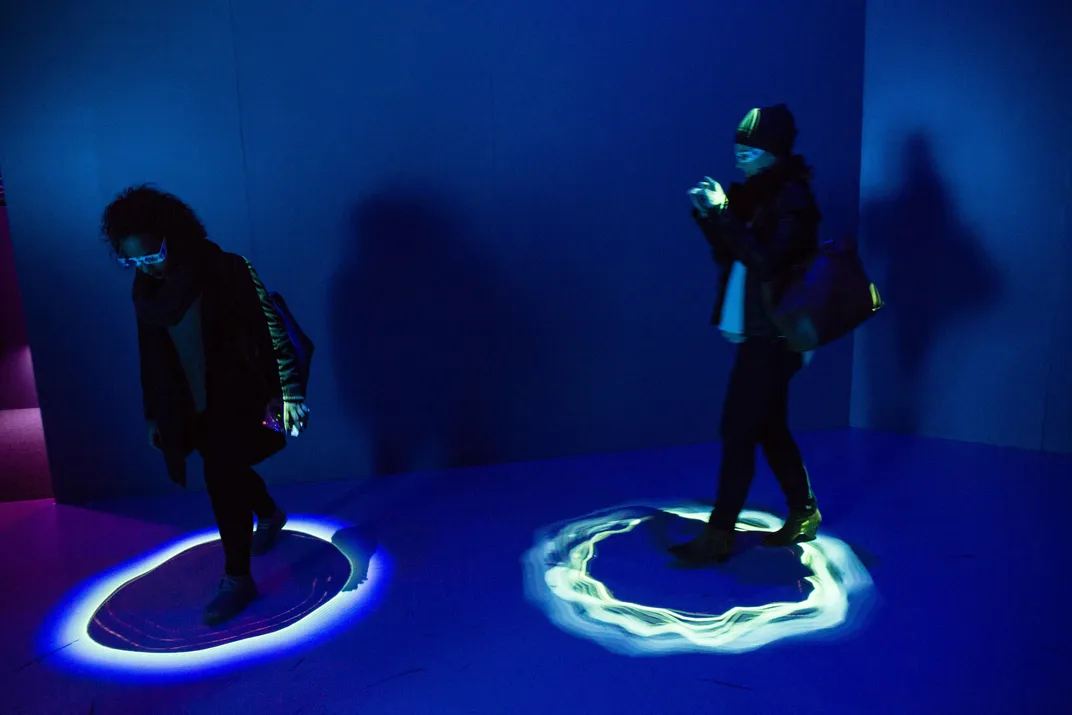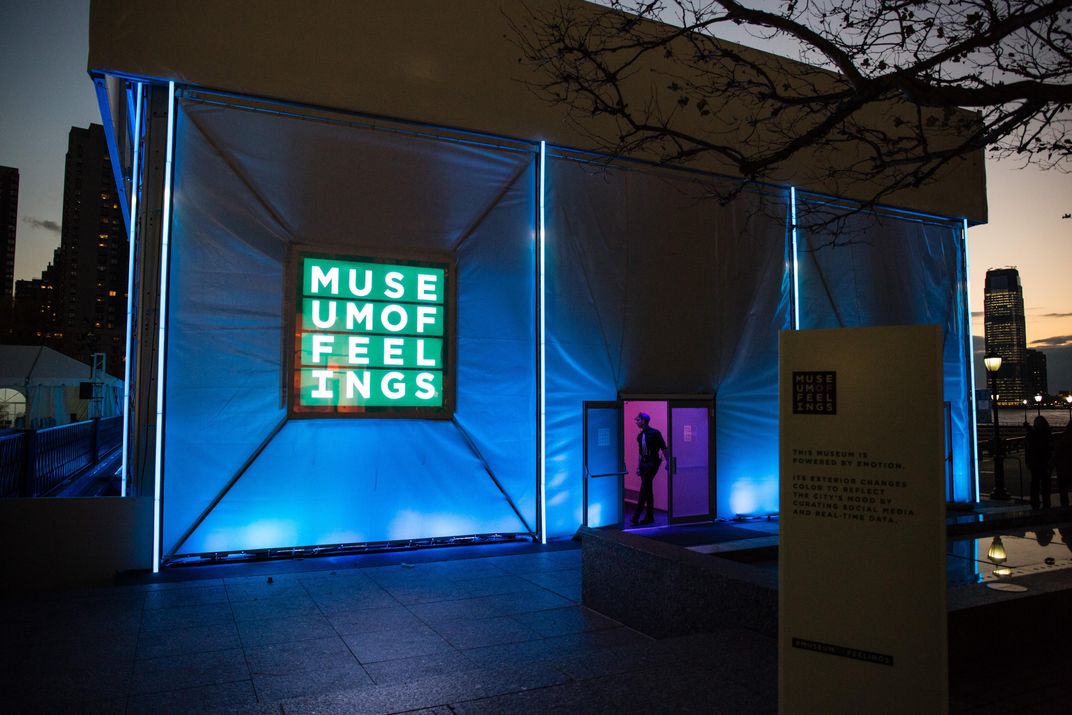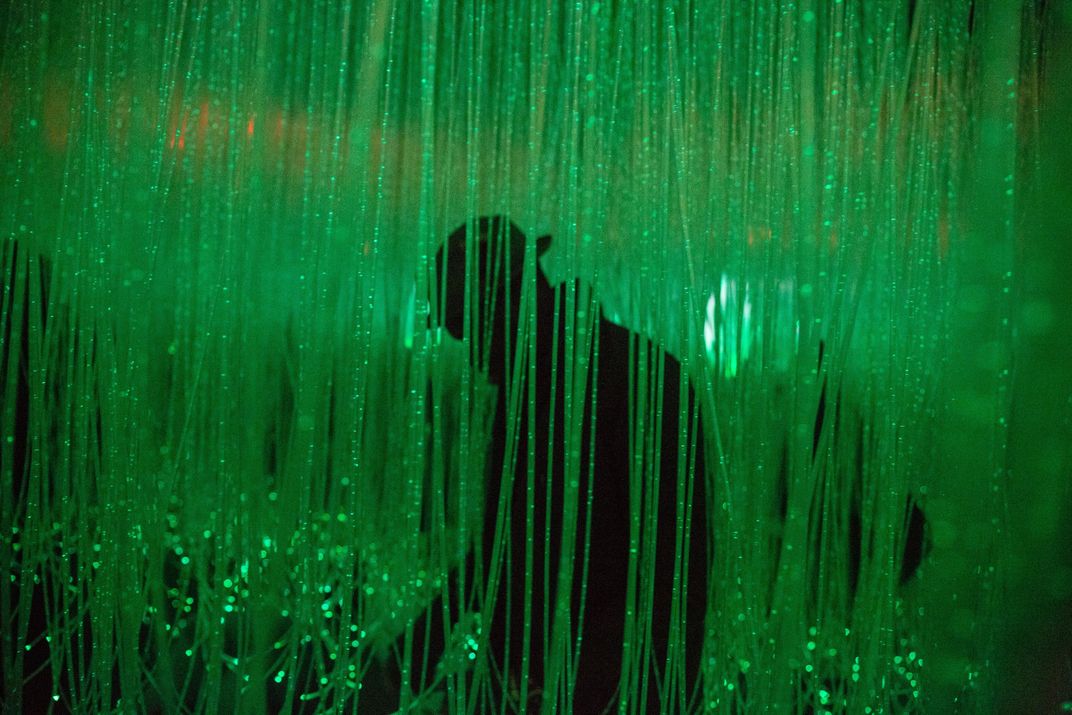Fear and Loathing at the Museum of Feelings
Can a corporate marketing stunt fulfill the raised expectations of a “museum”?
/https://tf-cmsv2-smithsonianmag-media.s3.amazonaws.com/filer/a1/a1/a1a1828d-7cc4-4f17-8de4-845656b8e82f/42-79553132.jpg)
As I step into the Museum of Feelings, all I feel is dread.
The pop-up museum, which bills itself as “the first museum that reacts to emotions—and turns them into art,” is an odd addition to the chrome-and-glass paneled buildings of Lower Manhattan's Battery Park City. Covered in a faint white canopy that sways against the wind and rain one evening in December, the museum resembles a giant plastic mausoleum, bathed in neon light like a set piece from a James Turrell installation (or the video for Drake’s mega-popular “Hotline Bling.”) The exterior color supposedly uses social media data to “reflect New York's ever-changing mood in vivid color;” the current light pink exterior indicates “calm” on the Museum of Feelings’ arbitrary mood scale. Which, considering that earlier this day, Twitter and Facebook were dominated by the news that two terrorists gunned down 14 people in San Bernadino, California, I’m not sure the museum’s barometer was all that accurate.
After waiting in a sprawling line for more than an hour, I enter the cube with a gaggle of college students in hipster chic. “Open up to an emotional journey,” the opening inscription reads. “Twist your inner mood to own.”
I do, and I immediately feel annoyed.
The Museum of Feelings doesn’t really have “exhibits” in the conventional sense; rather, visitors move from one themed alcove to another, five in total, each with its own distinctive aroma. The “Optimistic Room,” bathed in vivid pink and purple light, is little more than a lightshow, with patrons using small reflective panels to bounce light around the room. An attendant tells me the odor I smell is “Radiant Berries.” The “Joyful Room” is a dense jungle of green LED lights suspended in vine-like plastic tubes; the “Invigorated Room” encircles visitors in halos of bright light projected on the floor that respond to their movements. The “Exhilarated Room” is a funhouse of crystalline mirrors, like Superman’s Fortress of Solitude, dotted with flower-like patterns and accompanied by the putrid odor of what’s described to me as “Blooming Peony and Cherry.” The “Calm Room” is like stepping into a cloud, saturating us with a fine mist of “Vanilla and Lavender.”
The big “reveal” at the end of our tour is that Museum of Feelings is sponsored by Glade, hence all the olfactory elements to our sensory journey. Working off the idea that smell is the strongest sense tied to emotion, the SC Johnson company paired with marketing group Radical Media to engineer the five scents tied to our emotional state, so that each room “evoke each emotion in the abstract through visuals, touch, sound, and smell,” as Fast Company explained. At the end, visitors are offered a chance to buy candles and distillations of these scents from a “scent lab.”
I felt had.
But should I? After all, corporate sponsorship of museums is as old as the American museum system itself. The Metropolitan Museum of Art was founded by a handful of businessmen and financiers, and plutocrats like the Koch brothers have donated millions to support the arts and humanities across the country. The SC Johnson company itself pledged $5 million to the Smithsonian’s National Museum of American History for the renovation of the groundbreaking innovation wing that opened this year. During my time as an editor at Bloomberg, I had free access to most of the city’s museums thanks to the patronage of the company’s mayoral namesake. With corporate-sponsored art on the rise, is it possible that this marketing stunt could actually have the makings of a legitimate museum, with the scholarship and educational value that comes with that?
Certainly, but not in this case.
“This is more like a massage parlor than a museum.” says David Ward, a senior historian at the National Portrait Gallery in Washington, D.C., of the Museum of Feelings.
Ward points out that the presence of corporate money doesn’t necessarily invalidate a museum’s function as a collection of artifacts of historical or cultural importance. Consider the Corning Museum of Glass in New York, owned and operated as an extension of ceramics and glass manufacturer Corning Incorporated. “Despite the fact that it’s closely associated with the company, the museum was established to examine the history, science and technology of glassworking, and it’s become a respected institution even though it’s explicitly attached to a corporation,” says Ward.
The problem with the Museum of Feelings, rather, is that it lacks any sort of educational or pedagogical logic that defines every other museum in the country. Ward points to the Peale Museum, the first museum in the Western hemisphere established by Charles Peale in Baltimore in 1814.
“There was an explicit pedagogy at play in the Peale museum, and that has filtered down into almost every museum in America,” explains Ward. “This was an institution designed not just for us to learn about nature and man, but to make good citizens.” The Museum of Feelings is more akin to P.T. Barnum’s 19th-century amusements, which took the experience of observation and turned it into entertainment rather than education.
This is certainly my experience at the Museum of Feelings. The rooms are certainly interesting and evocative — “where we used to visit museums to see, say, a locomotive and woolly mammoth, now we go to see ourselves,” says Ward of the concept — but I don’t come away with any new knowledge or insights into the nature of human emotion. When I question the attendants in each special room about the composition of the exhibit, they can only incessantly repeat the names of the Glade-branded scents, like “Radiant Berries.”
Evan Schechtman, the CTO of Radical Media and chief design mind behind the Museum of Feelings, did not respond to request for comment, but in an interview with Fast Company, he indicated that he'll be measuring the success of his creation on social media. "Schechtman knows it is impossible to convey a four-sense experience through tweets and Instagram posts," writes Fast Company's David Lumb. "But if it's a knockout, he says, it will be reported as such."
But even Barnum’s regime of the fantastic, beginning with the opening of his American Museum in New York City in 1841, invoked the educational and skeptical next to his bizarre and exotic collections. “Barnum appealed to the public seeking both reality and pleasure,” wrote Jane Glaser and Artemis Zenetou of the entertainer’s impact on American museology in Museums: A Place to Work. “He invited one and all to observe and learn how these exotic and strange things actually worked. He openly invited skepticism, challenge, and debate, and was a genuine pioneer in his understanding of the educational and entertainment power of museums.” Barnum popularized natural history by inviting the public on an enthralling journey; the cheerful attendants at the Museum of Feelings seemed lost in their own space, lacking any working knowledge of the "exhibitions" themselves.
I turned to Amanda White, a neuroscience Ph.D at the University of Michigan and frequent writer on the relationship between smell and emotion, to understand the science underpinning the Museum of Feelings. She explained that while there’s certainly a special relationship between emotion and smell, more so than other senses, but it’s not nearly as clean-cut a relationship as the installation makes it seem.
“The regions of the brain [that] process olfaction, emotion, and memory are tightly connected, but it’s not a one-to-one relationship,” she says. “Memory is really the function that bridges the two. Somebody may have an extremely negative emotion tied to a scent because of the memories it evokes. Instead of connecting a feeling to a scent or color, it makes sense to focus on smells that most people will respond positively to, like the smell of baking cookies that brings back memories of childhood.”
By these metrics, is the Museum of Feelings a farce? Without some level of pedagogical logic and civic intent, is it simply an entertaining art installation, regardless of who foots the bill for its construction? In the eyes of historians like Ward, the Museum of Feelings represents a “clever attempt to conflate itself with something respectable.”
To Ward, it’s indicative of a larger trend in American culture: a tendency to crowdsource art and culture, to turn things to the masses, in lieu of the careful (if elitist) curation of scholars and academics that imparts museums with the knowledge and sensibility that makes them worthy stewards of the title.“Instead of rationality and pedagogy, we’re getting something closer to a carnival,” says Ward. “There’s no demonstrably larger social significance running through a place like the [Museum of Feelings] … so why are they pretending it’s something it isn’t?”
P.T. Barnum showed the world that entertainment and education can coexist, the Corning Museum succeeded at evolving a promotional vehicle into a reputable museum, and philanthropy has proven to be a valuable engine of museum scholarship and exhibitions. But in my view, a museum deserving of that name needs to offer a little bit more than a whiff of scented air freshener.


